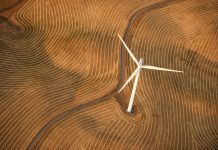Traditional wind turbines have been spinning and creating electricity for almost half a century.
And although the technology that creates that power has evolved over those years, one thing has gone pretty much unchanged: The turbines spin.
But a burgeoning technology on the horizon is looking to shake up how wind turbines harness the wind to create power by taking a cue from nature.
Instead of spinning, the blades on turbines being developed by Tyer Wind move like the wings of a hummingbird.
It’s called biomimicry — when scientists look to nature for solutions to better technology.
“It’s inspired from the famous hummingbird,” said inventor Anis Aouini. “It is the most efficient bird. The blade that rotates does not exist in nature. We cannot find any example worldwide.”

Aouinian Kinematics. (Courtesy: Tyer Wind)
Complex Biological Systems
Biomimicry and its offshoot, biomechanics, have been used to analyze complex biological systems.
How bird wings work has been studied for centuries. Leonardo De Vinci was fascinated with them, and many of his drawings and paintings reflect his in-depth study.
Tyer Wind says it has made that concept a reality. Tyer Wind is a startup in the field of wind energy R&D based in Tunisia.
The hummingbird was looked at for being nature’s most energetically efficient flyer. It has a unique morphology that allows it to flap its wings between 50 and 200 times a second. The hummingbird is the only bird that can hover and fly backwards.
Tyer Wind has taken how a hummingbird moves its wings and created a paradigm-shift vertical axis wind converter. Instead of traditional blades, it has “flapping wings” that convert wind energy into electricity based on 3D Aouinian Kinematics.

Aouini’s Discovery
The 3D Aouinian Kinematics, discovered by Aouini, converts a linear motion into a rotational one, giving it the capability of mimicking animals such as the hummingbird, insects, and fish in an efficient way.
In addition to wind energy, the application has potential in external and internal combustion engines, pumps, marine propulsion and more, according to Aouini.
“We can record many applications of biomimicry,” he said.
Growing Interest
The technology is still in its infancy, but Aouini said the interest in it has been growing.
“Everyday we are receiving many emails and requests from interested companies and government organizations,” he said.
But the seed of the idea only came about in the middle of 2016, when the concept was presented at an energy summit in Berlin.
The technology has been computer simulated, and a pre-industrial version already has been built that demonstrates the technology.
The machine is being put through various open-air tests that include power efficiency, aerodynamic behavior, material resistance, and stress over the mass.

Technological Advantages
But the results and the technology’s potential are promising, Aouini said.
Because the Tyer Wind technology converts the resultant force of the lift and drag into work, it has a limited level of drag. This has two big advantages: lower solicitation at the mast that results in lower civil work costs, and the converter can resist high wind velocity and generate more energy.
And since the blades oscillate instead of spin, the converter creates a limited vortex. This would allow more of Tyer Wind’s turbines in a wind farm as compared to traditional models.
The design gives it a flexibility to be used both on land and off shore, as well as making it an option for individual use to power a house up to a large wind farm.
“We believe our technology is a serious alternative to existing technology,” Aouini said. “It’s just a matter of time.”



























